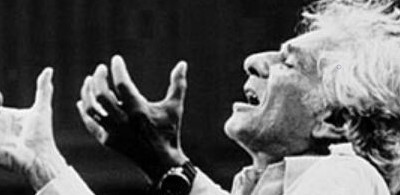“Beauty is truth, truth beauty”
Given the abysmal level of cultural literacy in the U.S. at present, it is utterly astonishing that some 50 years ago a nationally televised popular show like Leonard Bernstein’s “Young People’s Concert” series even existed on mainstream TV. By comparison, today’s television broadcasting only provides further evidence that we have slipped into the New Dark Ages.
On January 18, 1958, Leonard Bernstein (1918-1990) gave his very first televised Young People’s Concert at Carnegie Hall with the New York Philharmonic orchestra, of which he was the conductor. The What Does Music Mean lecture and concert was broadcast countrywide on CBS television, and the station judged the classical music concerts of such consequence that they were given the station’s prime time slot for three consecutive years. Imagine that happening on today’s commercial television networks.

During the 1958 concert Bernstein explained classical music as a creative force to a packed hall of youngsters not much older than I was at the time, and he conducted the orchestra in renditions of Rossini’s William Tell Overture and Beethoven’s Sixth Symphony. I faithfully watched the Young People’s Concert series as a child and the instructive presentations fired my imagination (between 1958 and 1972, their were 53 such concerts). Bernstein addressed youngsters without talking down to them, but the thing was, his delivery was so sophisticated that even adults unfamiliar with classical music were held mesmerized by the conductor’s lectures.
Since it is rarely mentioned, it might come as a surprise to aficionados of classical music that Bernstein was a political activist that held socialist ideas, and because of this the FBI put him under surveillance beginning in the early 1940s. In his book, Leonard Bernstein: The Political Life of an American Musician, author Barry Seldes noted that the director of the FBI, J. Edgar Hoover, “listed Bernstein for incarceration in a detention camp in the event of a national emergency”.
You owe it to yourself to watch that very first 1958 Carnegie Hall broadcast shown above. In the presentation Bernstein acknowledges a correlation between classical music and visual art;
“Now one of the best pieces that paint pictures is by a Russian Composer called Mussorgsky and he wrote a piece called ‘Pictures at an Exhibition.’ What Mussorgsky did was to take a lot of pictures hanging on the wall in a museum and write music that he thought could describe them – in other words, to try and do with notes what a painter does with paint. But of course notes can’t do what paint can do; you can’t draw your nose with F sharps, you can’t draw a building or paint a sunset with notes. But you can sort of try to do it.”
It amuses me that Bernstein wished he could “sort of try to do” what an artist does with paint, but the Maestro would undoubtedly have found my clumsy attempts at musicality to be just as entertaining. My passion for classical music has always been based on an appreciation of it being the highest achievement in the musical arts. Not only do I listen to it everyday, but I give it my attention when working at the easel. It is a grievous mistake to think of the genre as an exclusive area of interest for snobs and the well-to-do, it belongs to one and all. The high arts, which include classical music, prepare one for lofty thoughts, ideals and dreams, and without these we cannot hope to create a better world.
In his 1973 Harvard lecture series, The Unanswered Question, Leonard Bernstein addressed the question of aesthetics, and in doing so lobbed a grenade into the postmodern present. One can almost hear the gate keepers of the official art establishment diving for cover:
“(….) But these days, the search for meaning through beauty and vice versa becomes even more important as each day mediocrity and art-mongering increasingly uglify our lives; and the day when this search for John Keats’ truth-beauty ideal becomes irrelevant, then we can all shut up and go back to our caves.”
Bernstein was making reference to the 1819 poem Ode on a Grecian Urn by English Romantic poet John Keats, specifically the final two lines of the poem. Bernstein imagined Keats’ words as a philosophical guideline for civilization, and I concur. “‘Beauty is truth, truth beauty,’ – that is all Ye know on earth, and all ye need to know.'”





